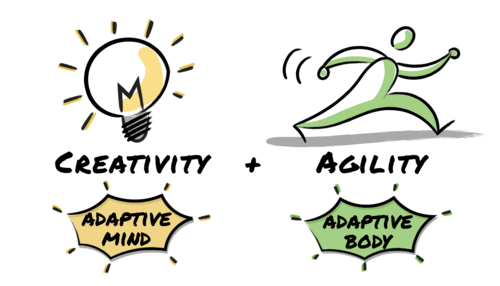COVID-19 — A Disruptor to How Managers Lead
COVID-19 is undoubtedly the biggest transformational driver in our lifetime--both in business and in our personal lives. Much like the Gold Rush of the 1850’s, the transportation boom in the late 1800’s and early 1900’s, the Great Depression of the 1920’s, and the world wars, COVID-19 has disrupted every aspect of work and social norms. Leaders, on the forefront of this disruption, have been required to change the way they lead in order to keep their businesses operating, developing and growing.
Companies within our Agile community are not immune and the disruptions associated with this pandemic inspired us to pivot and explore directions we thought were far in the future. This challenge, however, has also provided us an opportunity to rethink major aspects of how we do what we do. Disruption can be quite an effective catalyst!
In pivoting to an online workshop experience, we at ALJ did not simply look to a temporary solution in how to deliver classes online for the duration of the pandemic. Rather, we evaluated other market shifts driving online education like corporate globalization, climate change and technology advancements. This led us to refactor the delivery of our educational services and to invest in a system that better prepares us for the future.
COVID-19 is not an anomaly. Rather, it is a milestone on a broader global disruption timeline, which also includes disruptions from climate change, social turmoil, technological advancement, political polarization and more. Only temporarily changing your leadership for the current global health pandemic would be a mistake. This article explores four focus points to challenge your leadership for a new disruptive world of work, even when COVID-19 is in the rearview mirror.
Control
You know all too well that the pandemic has cut short many businesses, but not all. Many office jobs, though remote, have had to accelerate their efficiency in order to keep up with the growing workload. But one cannot ignore the stress and fatigue caused by the pandemic and other global disruptions.
In moments of high stress or trauma, our bodies enter fight, flight or freeze states. As leaders, we need to recognize the way our people react in stressful moments and act accordingly. Listen to the immediate needs of your employees and drive support to your teams. Be more directive than you might have been in the past to help keep your team focused. Control does not mean micro-manage. Rather, the actions taken by a leader in the control stage are intended to bring calm to your organization and to be a confident presence for people in the face of chaos.
Think of FDR’s fireside chats. His presence helped calm Americans during the Great Depression and Second World War. He was not dictating how to feel or airing his grievances. Rather, his presence was meant to expel rumors, provide the facts of the situation, and be a voice of reason for those looking to cast their hopes on something stable. Leaders in crisis succeed when they have control over their particular situation and can speak and act to establish order.
Caution: There is a risk in getting stuck in a mode of control. For example, Rudy Guliani, while very effective as a controlling leader in the chaos on 9/11, was unable to effectively transition to the ongoing leadership following the chaos. Effective leaders recognize the temporary nature of the control chaos space and will want to move into the next three stages expeditiously.
Clarify
Your team may be worried about their jobs, about the future of the company, whether things will keep shifting or if things will stabilize. The fear of the unknown creates stress, fogs focus and impedes progress. Clarity reverses this. Even if you do not have any action or say on the overall company, you can increase transparency and connect them to the near-term goals of the organization.
Reduce uncertainty by narrowing the focus of work with shorter-term goals and more incremental milestones. Meet more regularly with your team to provide status updates and engage in daily briefings or standups. Overshare the process, erring on the side of more communication than less.
Andrew Cuomo, the Governor of New York, in the early days of the coronavirus pandemic increased the frequency and transparency of his communication with the public. His visible presence and consistent messaging provided clarity on the current priorities and focus for many communities. Furthermore, to address the longer-term goal of flattening the infection curve, he focused tactically with attainable weekly actions and targets.
Caution: Clarifying the near-term focus does not forgo long-term direction. Rather, near-term clarity is in service of the longer-term direction by helping to ground people to more tangible goals and connecting them to the more abstract direction, especially in a disruptive environment.
Create
Whether you’re tired of the phrases “the new normal” or “the only constant in life is change” or not, it is abundantly clear that disruption is quickening and requires creative exploration of alternative ways to achieve our business goals. “No plan survives contact with the enemy” is another apropos quote, where in this case the enemy is global disruption. Agility becomes the master skill amid change and disruption.
This applies to your thinking, too. Creativity is agility of the mind. In a disruptive environment, leveraging the past is less effective than pivoting forward. This starts with you, as a leader. Be open to new ways of leading and to feedback as you explore different leadership practices. Embrace change and be willing to pivot. Engage and empower teams to improve collaboration and decision making. Often our best moves as leaders are when we are authentic and adaptive to the needs of the moment.
Brené Brown, leadership researcher and author of Dare to Lead, shares that it takes courage to be vulnerable. Not having all of the answers, experimenting on new ways of doing things, and letting go with your teams feels vulnerable as a leader. Yet, this is what it takes to draw others to spark and enhance the creative process, especially through disruptions.
Caution: Pivoting through creative discovery does not counter vision and direction. Leaders must provide clarity in vision and yet retain agility in execution as new information surfaces or further disruptions occur.
Connect
Shifts to more remote collaboration, with less opportunities for in-person interactions and the loss of a social office environment, can lead to employee isolation, detachment and strained relationships. All of these hinder employees from working together across the organization and limit the ability to effectively seize opportunities
Leaders must shift their focus from the work being done to the people who do it. Design intentional human connections, such as virtual happy hours and hangouts. Join online meetings a few minutes early to create space for casual conversations. Connect through asking personal questions and expressing interest in their personal lives, which are likely as disrupted as our work lives. Communities are better equipped to deal with disruption than individuals - leverage the community for shared empathy and support.
To paraphrase Peter Block, author and expert in organizational development, community building, and civic engagement, cultural change is only possible when it is preceded by relationships and connectedness among its members. Block encourages leaders to transform the isolation, fear, and self-interest into connectedness and caring for the whole by starting with accountability and generosity amongst the members of a community or organization.
Caution: Connection listed as the last step does not suggest that the human connection is less important. Catalyst Leaders always seek to balance their focus on the work and the people doing the work.
Conclusion
COVID-19, while likely the most significant disruptor to our work lives, is not an isolated event. Disruption in the global economy is the new normal leaders must not only recognize but leverage to disrupt their own leadership approach, enabling themselves, their people and their organizations to survive and prosper in the years ahead. Catalyst Leadership is not merely pandemic leadership, it is disruption leadership for our disrupted world and times.
Learn More
If you found this article interesting, you might appreciate learning more about the mistakes leaders are making. Download our ebook “Five Mistakes Leaders Are Making” to increase your own awareness and improve your leadership in this new disruptive economy.









